Lego-like Bricks Manufacturing Using Recycled Polyethylene (PE) and Polyethylene Terephthalate (PET) Waste in Egypt
Abstract
:1. Introduction
2. Research Significance and Knowledge Gap
- Recycling plastic waste (PE and PET) into eco-friendly Lego bricks can help reduce the amount of microplastics in the environment.
- Reducing factory emissions from kilns and cement, and preserving environmental natural resources such as clay, gravel, and the scarcest water by introducing Lego-like bricks that are made of plastic waste as a substitute for conventionally used bricks.
- Selecting and designing the operating temperature of the new mixture is considered difficult due to PET and PE having different melting points, and this is essential to achieve the optimized adhesive bond. Mixing two different types of plastics has never been studied. However, it is considered a good idea to use multiple types of plastic waste to decrease sorting time as there is no need to remove the bottle labels or caps from it (as the bottle is made from PET and the label and cap are made from PE), which will lead to a reduction in separation and sorting costs.
3. Materials and Methods
3.1. Materials
3.2. Specimen Details
3.3. Mixtures’ Proportioning
3.4. Samples’ Preparation
3.5. Testing Procedures
3.6. Emissions
4. Results and Discussion
4.1. Physical Properties
4.2. Water Absorption
4.3. Mechanical Properties
4.4. Fracture Pattern
4.5. Effect of Heating on Mechanical Properties
4.6. Thermal Properties
4.7. Environmental Properties
4.8. Lego-like Bricks
5. Conclusions
- From a physical standpoint, there will be no fear of increasing wall loads on the structure, as the unit weight values have proven to be compatible with clay and cement bricks.
- The unit weight of plastic bricks decreases as the percentage of plastic increases, and the PE/PET/sand samples were the least.
- It is expected that plastic bricks will be better in terms of resistance to moisture factors, as the samples gave zero water absorption values.
- Compressive strength results proved a significant superiority of plastic bricks over clay and cement bricks. The PET/sand samples gave a compressive strength of approximately 70 MPa.
- It can be concluded that the optimal percentage of plastic ranges between 30% and 40% to obtain the highest possible strength in any of the mixtures.
- All plastic samples showed a decrease in compressive strength values when exposed to temperatures of 40 °C and 60 °C, and the PE/sand samples were the most affected by a decrease value of approximately 43%. This decrease does not raise concerns regarding compressive strength, as the strength values are still higher than those in the construction market. The most important is to study other properties that may have been affected and were not covered in this research.
- The thermal properties’ results demonstrated a significant convergence between the values of plastic and clay bricks. This also gives an incentive to use these bricks in the walls of buildings as a thermal insulator that helps reduce energy consumption.
- Lego-like bricks are easy to install and do not require mortar like cement and red bricks, leading to labor, time and cost savings.
- For the environment, the emissions measurements used in this study proved that plastic bricks emit significantly less CO2 than cement and red bricks. This means that the Lego-like bricks have no direct effect on increasing concentrations of GHGs.
- Lego-like bricks are recommended for use on interior walls or room-splitting building blocks until further research is conducted regarding the degradation rates in open areas.
6. Recommendations
Author Contributions
Funding
Institutional Review Board Statement
Informed Consent Statement
Data Availability Statement
Acknowledgments
Conflicts of Interest
Abbreviations
| PE | Polyethylene |
| PET | Polyethylene Terephthalate |
| MSW | Municipal Solid Waste |
| EEAA | Egyptian Environmental Affairs Agency |
| GHGs | Greenhouse Gases |
| CO2 | Carbon Dioxide |
| SO2 | Sulfur Dioxide |
| NO | Nitrogen Oxide |
| UNICEF | United Nations International Children’s Emergency Fund |
| LDPE | Low Density Polyethylene |
| PP | Polypropylene |
| HDPE | High Density Polyethylene |
| QD | Quary Dust |
| SiO2 | Silicon dioxide |
| Al2O3 | Aluminum oxide |
| Fe2O3 | iron oxide |
| CaO | Calcium oxide |
| MgO | Magnesium oxide |
References
- MOE; EEAA. Environmental State Report; Ministry of Environment: Cairo, Egypt, 2019. [Google Scholar]
- Wang, G.-X.; Huang, D.; Ji, J.-H.; Völker, C.; Wurm, F.R. Seawater-Degradable Polymers—Fighting the Marine Plastic Pollution. Adv. Sci. 2021, 8, 2001121. [Google Scholar] [CrossRef] [PubMed]
- Abdel Tawab, O.; Amin, M.; Ibrahim, M.; Abdel Wahab, M.; Abd El Rahman, E.; Hassanien, R.; Hatem, M.; Ghaly, A.E. Recycling waste plastic bags as a replacement for cement in production of building bricks and concrete blocks. J. Waste Resour. Recycl. 2020, 1, 202. [Google Scholar]
- Kaplan, S. By 2050, there will be more plastic than fish in the world’s oceans, study says. The Washington Post, 20 January 2016; 20. [Google Scholar]
- Alsobky, A.; Ahmed, M.; Al Agroudy, S.; El Araby, K. A smart framework for municipal solid waste collection management: A case study in Greater Cairo Region. Ain Shams Eng. J. 2023, 14, 102183. [Google Scholar] [CrossRef]
- MOE; EEAA. Environmental State Report; Ministry of Environment: Cairo, Egypt, 2020. [Google Scholar]
- Jambeck, J.R.; Geyer, R.; Wilcox, C.; Siegler, T.R.; Perryman, M.; Andrady, A.; Narayan, R.; Law, K.L. Plastic waste inputs from land into the ocean. Science 2015, 347, 768–771. [Google Scholar] [CrossRef] [PubMed]
- Verma, R.; Vinoda, K.; Papireddy, M.; Gowda, A. Toxic pollutants from plastic waste—A review. Procedia Environ. Sci. 2016, 35, 701–708. [Google Scholar] [CrossRef]
- Ministry of Environment. Egypt’s Firat Biennial Update Report to the United Nations Framework Convention on Climate Change; Environmental Affairs Agency: Cairo, Egypt, 2018. [Google Scholar]
- Khalil, E.A.; AbouZeid, M.N. Computation of the environmental performance of ready-mix concrete for reducing CO2 emissions: A case study in Egypt. Energy Rep. 2023, 9, 144–148. [Google Scholar] [CrossRef]
- Ministry of State of Environmental Affairs. Environmental State Report; Ministry of State of Environmental Affairs: Cairo, Egypt, 2018. [Google Scholar]
- United Nations Children’s Fund. UNICEF Annual Report; UNICEF: New York, NY, USA, 2021. [Google Scholar]
- Abohelal, M.; Nour, W.; Eldarwish, I.I.; Dewair, H. An Innovative Sustainable Approach in the Manufacturing of Recycled Brick Mixture for Buildings. J. Eng. Res. 2022, 6, 54–58. [Google Scholar] [CrossRef]
- Wahid, S.A.; Rawi, S.M.; Desa, N.M. Utilization of plastic bottle waste in sand bricks. J. Basic Appl. Sci. Res. 2015, 5, 35–44. [Google Scholar]
- Sahani, K.; Joshi, B.R.; Khatri, K.; Magar, A.T.; Chapagain, S.; Karmacharya, N. Mechanical properties of plastic sand brick containing plastic waste. Adv. Civ. Eng. 2022, 2022, 8305670. [Google Scholar] [CrossRef]
- Akinyele, J.; Igba, U.; Adigun, B.G. Effect of waste PET on the structural properties of burnt bricks. Sci. Afr. 2020, 7, e00301. [Google Scholar] [CrossRef]
- Ali, D.C.; Jassim, A.K.; Al-Sabur, R. Recycling of Polyethylene and Polypropylene Waste to Produce Plastic Bricks. J. Sustain. Dev. Energy Water Environ. Syst. 2023, 11, 1–13. [Google Scholar] [CrossRef]
- Agrawal, R.; Singh, S.K.; Singh, S.; Prajapat, D.K.; Sudhanshu, S.; Kumar, S.; Đurin, B.; Šrajbek, M.; Gilja, G. Utilization of Plastic Waste in Road Paver Blocks as a Construction Material. CivilEng 2023, 4, 1071–1082. [Google Scholar] [CrossRef]
- Gounden, K.; Mwangi, F.M.; Mohan, T.P.; Kanny, K. The use of recycled high-density polyethylene waste to manufacture eco-friendly plastic sand bricks. SPE Polym. 2023, 5, 20–34. [Google Scholar] [CrossRef]
- Krishnan, A.K.; Wong, Y.C.; Zhang, Z.; Arulrajah, A. Recycling of glass fines and plastics in clay bricks at low temperatures. Proc. Inst. Civ. Eng.-Waste Resour. Manag. 2022, 176, 153–161. [Google Scholar] [CrossRef]
- Tulashie, S.K.; Dodoo, D.; Ibrahim, A.A.-W.; Mensah, S.; Atisey, S.; Odai, R.; Mensah, D. Recycling plastic wastes for production of sustainable and decorative plastic pavement bricks. Innov. Infrastruct. Solut. 2022, 7, 265. [Google Scholar] [CrossRef]
- Koppula, N.K.; Schuster, J.; Shaik, Y.P. Fabrication and Experimental Analysis of Bricks Using Recycled Plastics and Bitumen. J. Compos. Sci. 2023, 7, 111. [Google Scholar] [CrossRef]
- ES:4763/2006; Building Brick Masonry Units Made From Clay. Egyptian Organization for Standards and Quality: Cairo, Egypt, 2006.
- ES:1292-2/2005; Concrete Masonry Units Part 2: Nonload Bearing Concrete Masonry Units. Egyptian Organization for Standards and Quality: Cairo, Egypt, 2005.
- ASTM C62-23; Standard Specification for Building Brick (Solid Masonry Units Made from Clay or Shale). ASTM International: West Conshohocken, PA, USA, 2023.
- ASTM C129-23; Standard Specification for Nonloadbearing Concrete Masonry Units. ASTM International: West Conshohocken, PA, USA, 2023.
- Zhang, L. Production of bricks from waste materials—A review. Constr. Build. Mater. 2013, 47, 643–655. [Google Scholar] [CrossRef]



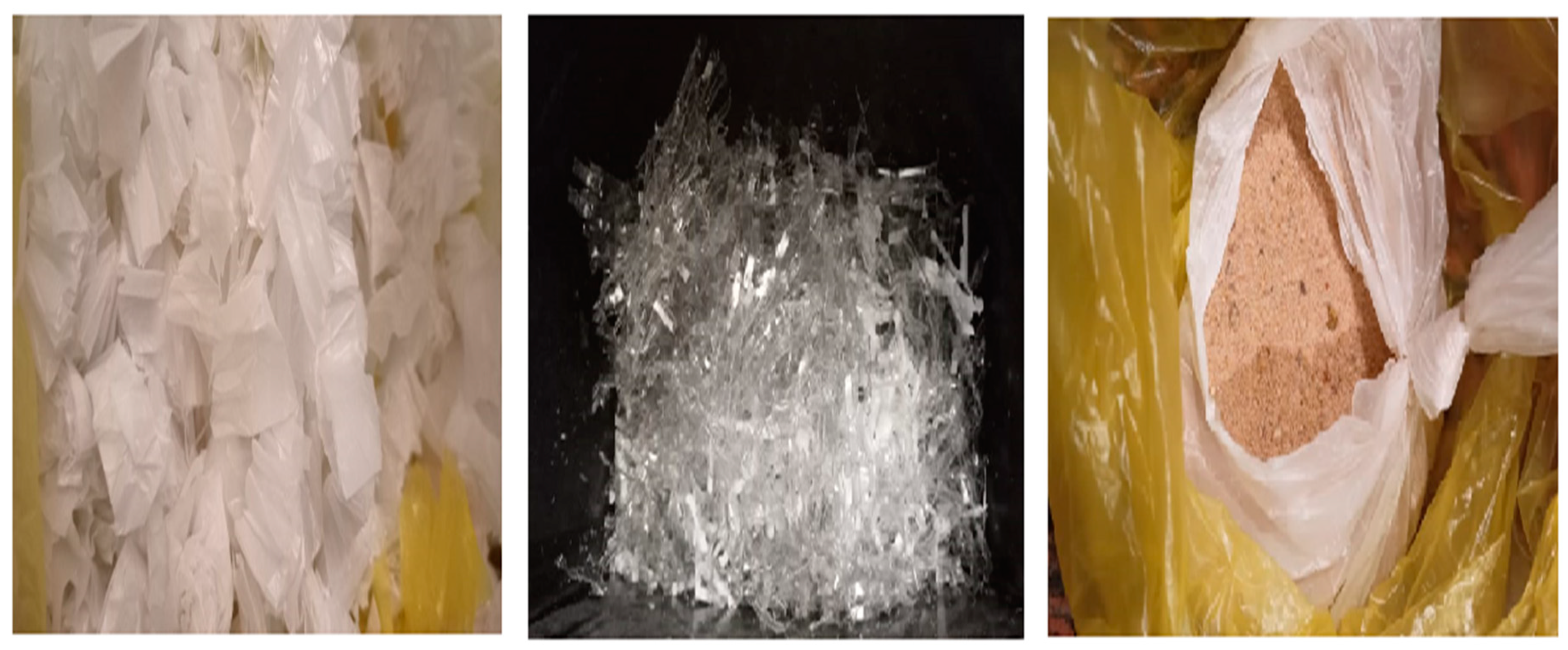


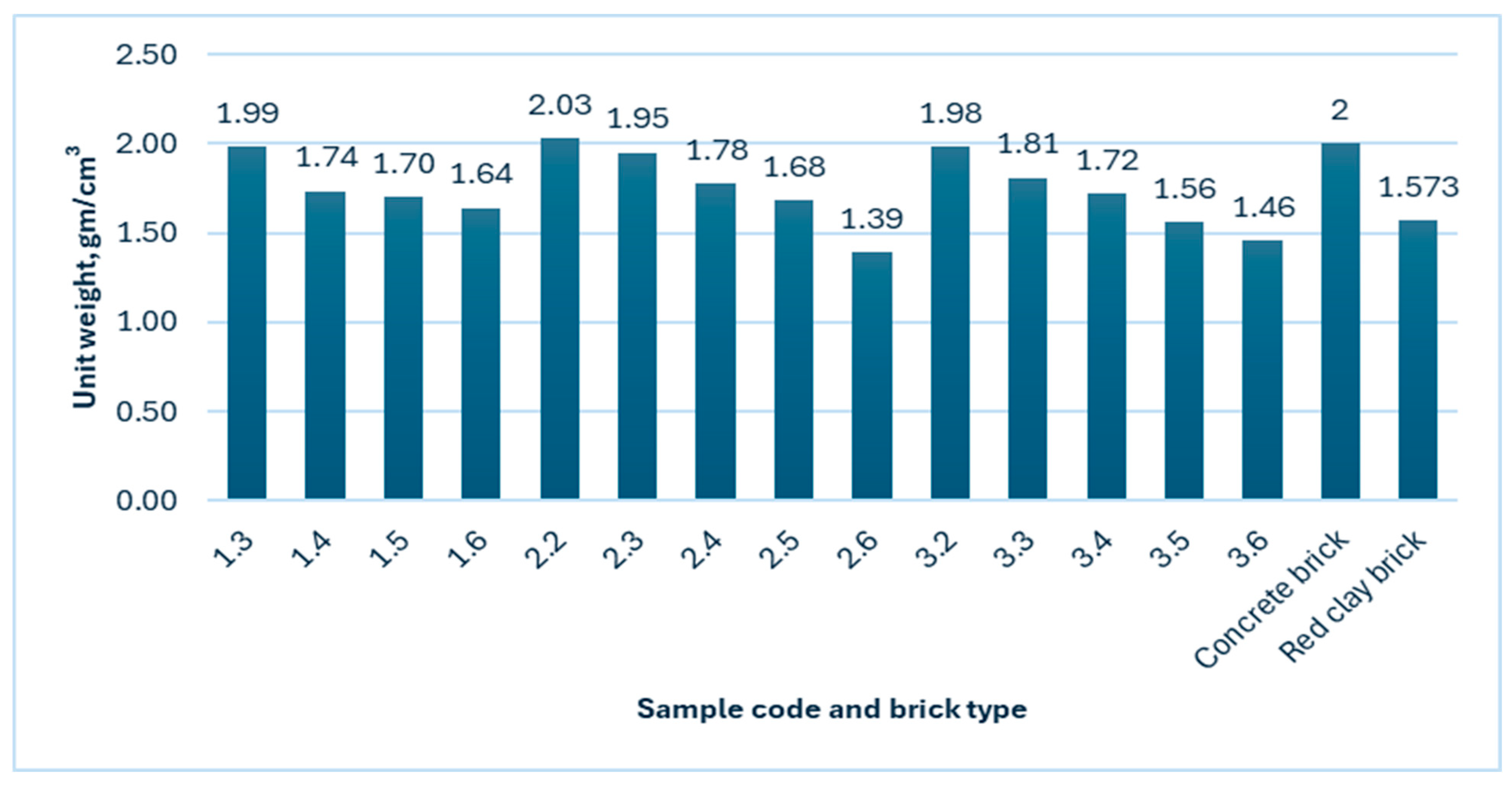
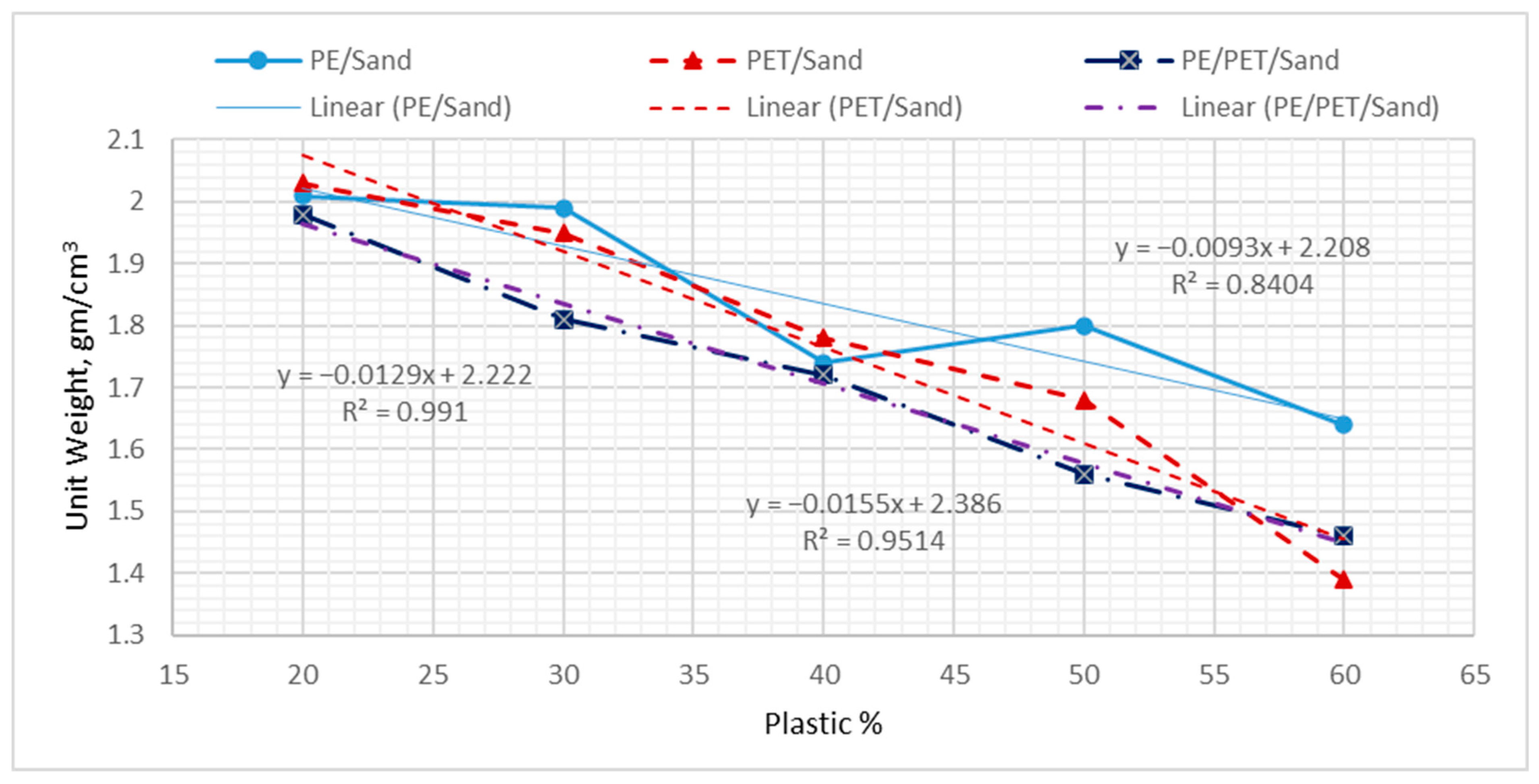


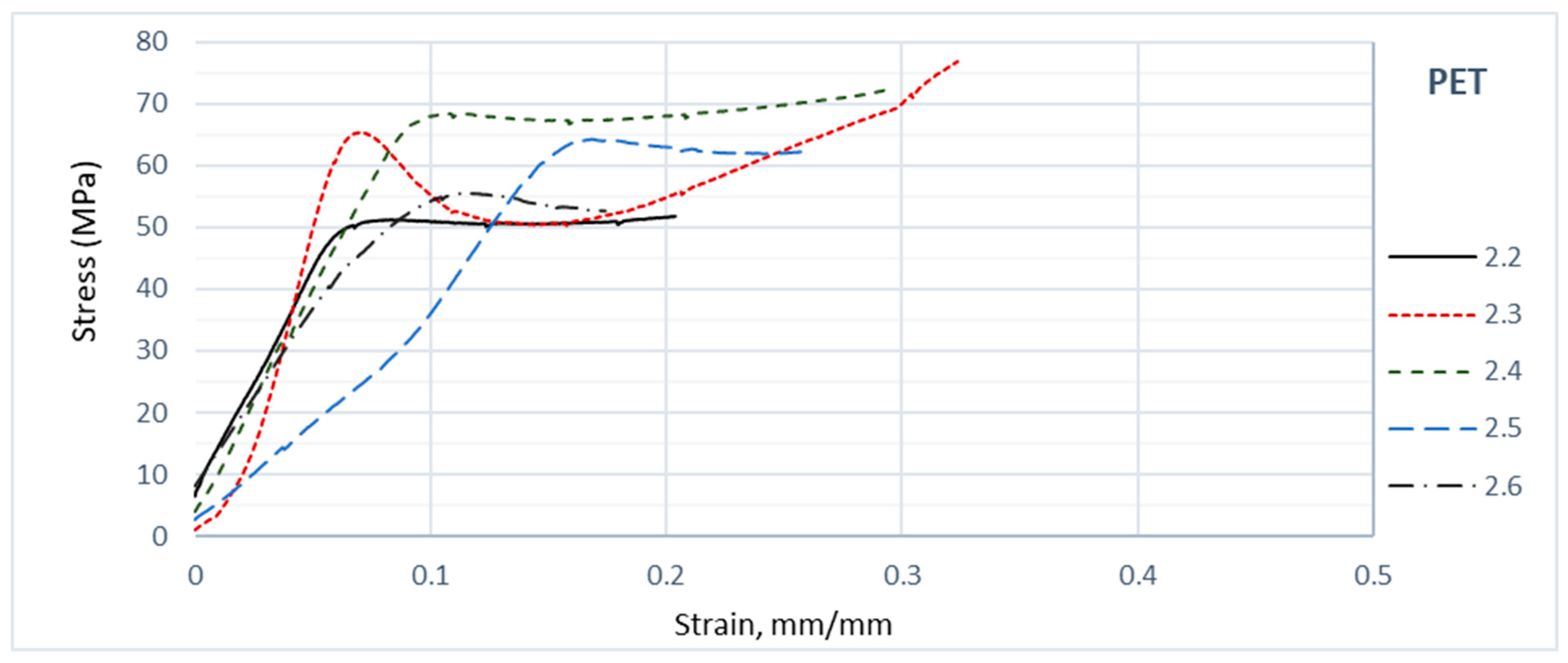
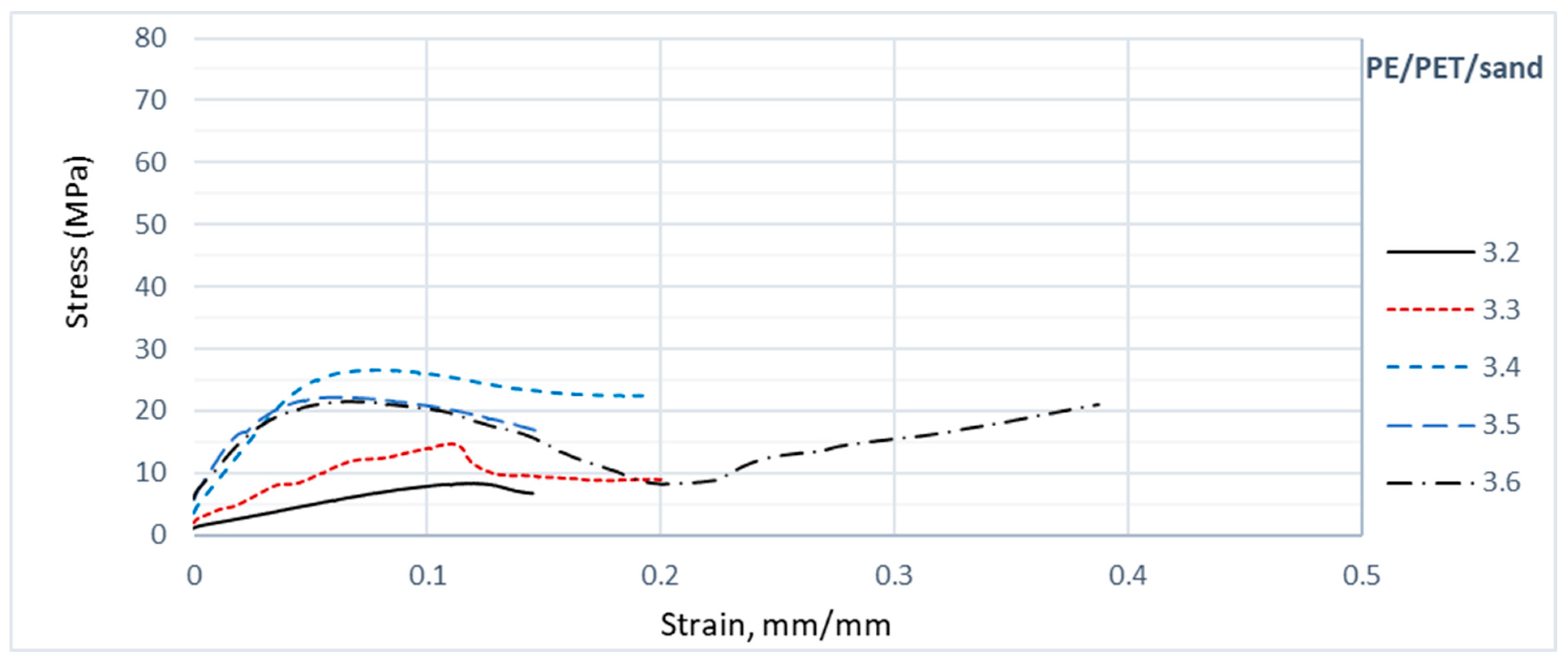

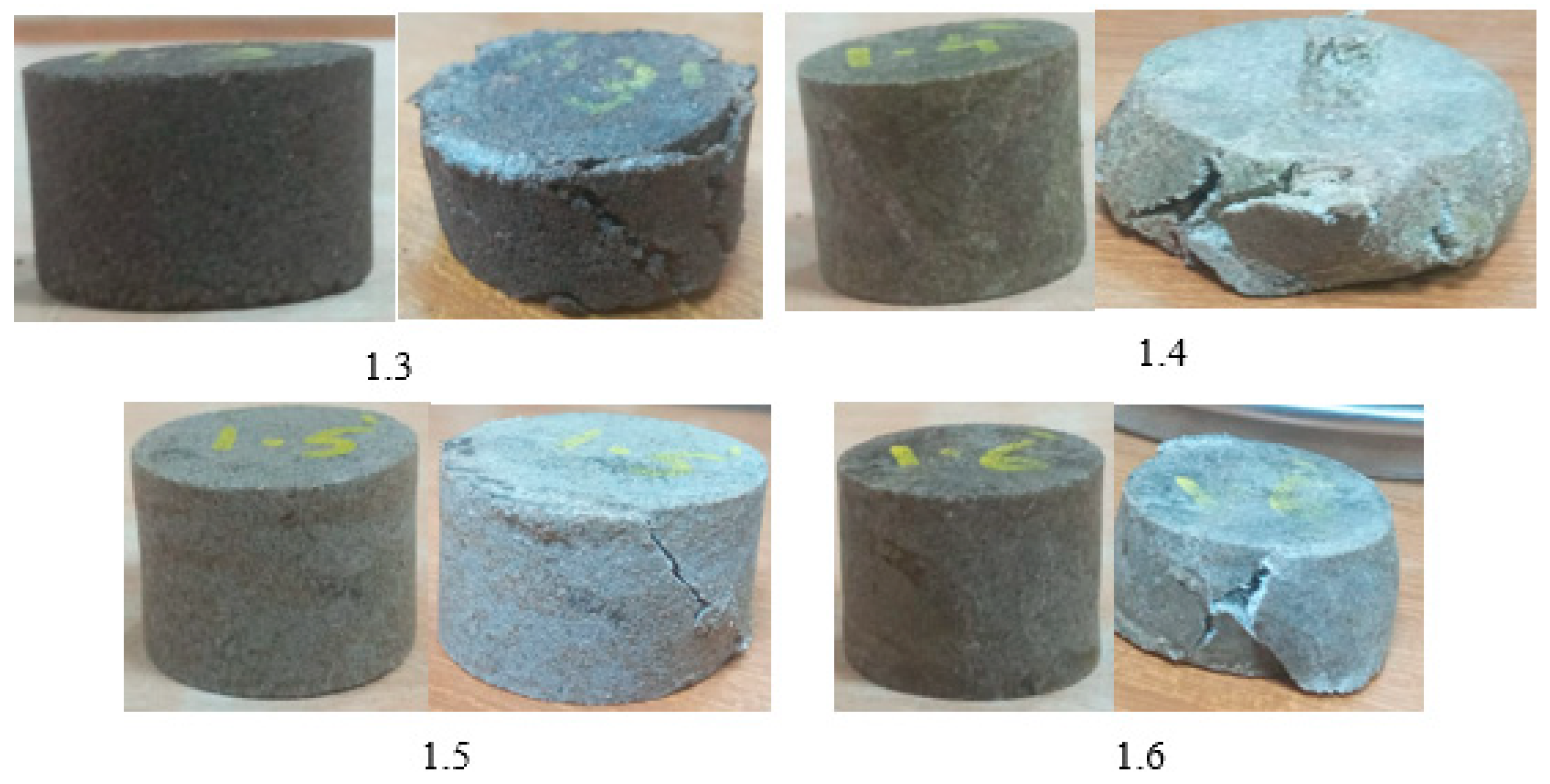
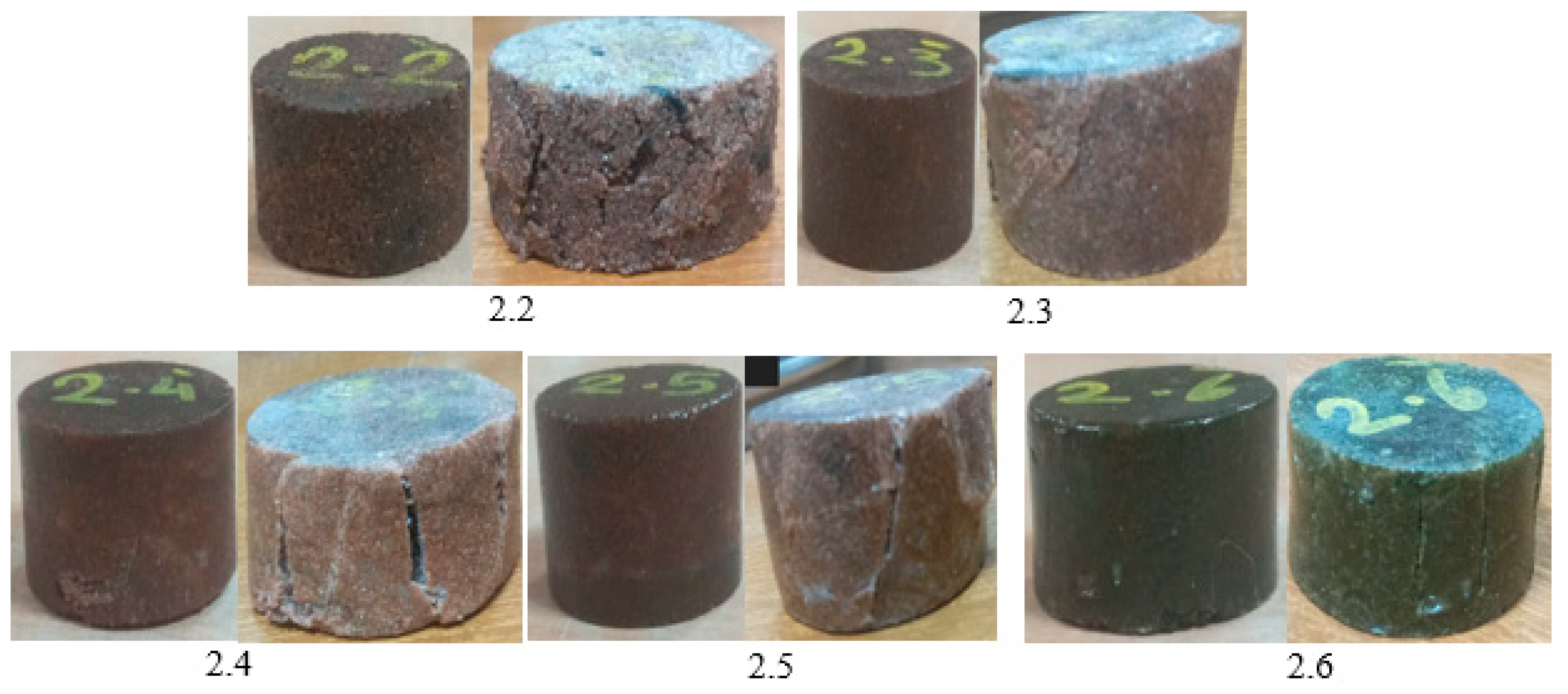


| No. | Mix Type | Sample Code | Mix Proportioning (%) | ||
|---|---|---|---|---|---|
| PE | PET | Sand | |||
| 1 | PE | 1.2 | 20 | - | 80 |
| 2 | 1.3 | 30 | - | 70 | |
| 3 | 1.4 | 40 | - | 60 | |
| 4 | 1.5 | 50 | - | 50 | |
| 5 | 1.6 | 60 | - | 40 | |
| 6 | PET | 2.2 | - | 20 | 80 |
| 7 | 2.3 | - | 30 | 70 | |
| 8 | 2.4 | - | 40 | 60 | |
| 9 | 2.5 | - | 50 | 50 | |
| 10 | 2.6 | - | 60 | 40 | |
| 11 | PE/PET | 3.2 | 10 | 10 | 80 |
| 12 | 3.3 | 15 | 15 | 70 | |
| 13 | 3.4 | 20 | 20 | 60 | |
| 14 | 3.5 | 25 | 25 | 50 | |
| 15 | 3.6 | 30 | 30 | 40 | |
| Sample Type | Sample No. | Compressive Strength MPa | ||
|---|---|---|---|---|
| Room Temperature (Fo) | 40 °C (F40) | 60 °C (F60) | ||
| PE/sand | 1.3 | 23.42 | 17.98 | 16.00 |
| 0.77 Fo | 0.68 Fo | |||
| 1.4 | 38.65 | 21.99 | 19.94 | |
| 0.57 Fo | 0.52 Fo | |||
| PET/sand | 2.3 | 76.85 | 56.72 | 54.40 |
| 0.74 Fo | 0.71 Fo | |||
| 2.4 | 72.16 | 59.10 | 56.20 | |
| 0.82 Fo | 0.78 Fo | |||
| PE/PET/sand | 3.3 | 14.75 | 14.07 | 12.97 |
| 0.95 Fo | 0.88 Fo | |||
| 3.4 | 26.64 | 26.00 | 23.93 | |
| 0.98 Fo | 0.90 Fo | |||
| Sample | Thermal Conductivity W/(m/K) | Thermal Diffusivity mm2/s | Volumetric-Specific Heat Capacity MJ/m3K | Thermal Effusivity Ws−1/2/(m2K) | |
|---|---|---|---|---|---|
| Type | No. | ||||
| PE | 1.3 | 1.057292 | 0.990505 | 1.572974 | 1565.02 |
| 1.4 | 0.928632 | 0.791084 | 1.174437 | 1044.259 | |
| PET | 2.3 | 0.808905 | 0.974039 | 0.8309 | 819.7808 |
| 2.4 | 0.874074 | 1.061212 | 0.823958 | 848.6113 | |
| PE/PET/sand | 3.3 | 0.972773 | 0.565957 | 1.721177 | 1293.75 |
| 3.4 | 1.021558 | 0.998219 | 1.026112 | 1023.535 | |
| Type of Emission per Brick | Clay Brick | Concrete Brick | Lego-like Brick | |||||
|---|---|---|---|---|---|---|---|---|
| 1.3 | 1.4 | 2.3 | 2.4 | 3.3 | 3.4 | |||
| CO2 per brick (kg) | 0.41 | 0.12 | 0.008 | 0.0085 | 0.0085 | 0.009 | 0.0065 | 0.007 |
Disclaimer/Publisher’s Note: The statements, opinions and data contained in all publications are solely those of the individual author(s) and contributor(s) and not of MDPI and/or the editor(s). MDPI and/or the editor(s) disclaim responsibility for any injury to people or property resulting from any ideas, methods, instructions or products referred to in the content. |
© 2024 by the authors. Licensee MDPI, Basel, Switzerland. This article is an open access article distributed under the terms and conditions of the Creative Commons Attribution (CC BY) license (https://creativecommons.org/licenses/by/4.0/).
Share and Cite
Ashraf, N.; El-Monayeri, O.D.; Hassan, H.A. Lego-like Bricks Manufacturing Using Recycled Polyethylene (PE) and Polyethylene Terephthalate (PET) Waste in Egypt. Sustainability 2024, 16, 8567. https://doi.org/10.3390/su16198567
Ashraf N, El-Monayeri OD, Hassan HA. Lego-like Bricks Manufacturing Using Recycled Polyethylene (PE) and Polyethylene Terephthalate (PET) Waste in Egypt. Sustainability. 2024; 16(19):8567. https://doi.org/10.3390/su16198567
Chicago/Turabian StyleAshraf, Nada, Ola D. El-Monayeri, and Hassan A. Hassan. 2024. "Lego-like Bricks Manufacturing Using Recycled Polyethylene (PE) and Polyethylene Terephthalate (PET) Waste in Egypt" Sustainability 16, no. 19: 8567. https://doi.org/10.3390/su16198567







